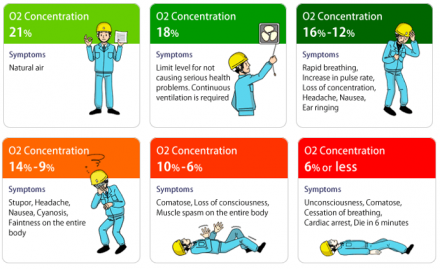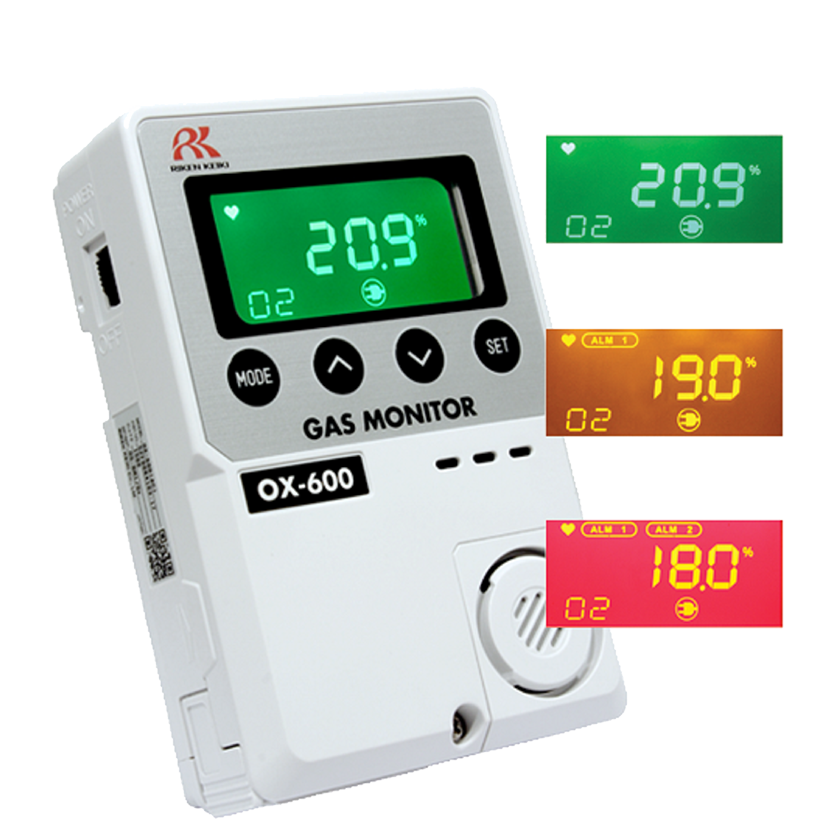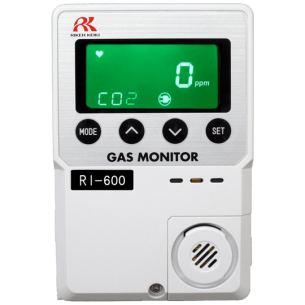The Issue
Oxygen Deficiency
Laboratories regularly use inert gases in a number of applications. Helium and Argon, for example, provide a stable inert atmosphere within glove-boxes by purging the Oxygen. In addition they provide the same function in Additive Manufacturing (AM) machines and 3D printer chambers. Liquid Nitrogen is also used to provide temperatures as low as -196°C . This makes it ideal for use in Cryo-biology, Cryo-Surgery and General Cryogenic research.
Laboratories focus on health and safety because if these Inert Gases escape they can rapidly displace Oxygen from the air. This situation rapidly creates an very unsafe environment. A person can become unconscious without warning when the Oxygen concentration is sufficiently low. Death by asphyxiation can quickly follow. See diagram below

The Oxygen Deficiency Solution
The Riken Keiki OX-600 is a Stand-Alone Oxygen Deficiency monitor. In addition it can provide a low cost solution for monitoring Oxygen enrichment. Oxygen Enrichment can be a combustion hazard in a situation where re-active materials are being used.

Oxygen Deficiency Monitor
Many facilities store and use quantities of Inert Gas. Laboratories are typical of this type of establishment. In addition Hospitals, Hospices and Cryogenic storage units use and store inert gases.
Visual and Audible Oxygen Alarms
The OX-600 displays Oxygen levels on an LCD screen that changes colour at each alarm level. This is a unique to the Riken Keiki 600 series, indeed HSE Inspectors are Increasingly looking for this feature in Gas Monitors.
The Unit comes with two preset alarms set to Low and Low Low. The user can program the alarms to other levels if desired. The OX-600 provides relay outputs for the 1st and 2nd alarms in addition there is a 4-20mA output. These features allow customers to connect to optional external accessories such as additional sounders beacons etc. Users can also connect a data-logger using this feature as well Drive other external items ( see below ).
The Instrument comes ready to operate from a 24 VDC Power supply (an optional mains adapter provides 240VAC operation if required). In addition a Battery Powered option is available.
Remote Oxygen ( O2 ) Sensor
The OX-600 has the option of an extender cable. The use of an extender cable allows the unit to be mounted outside the room with the sensor inside. Staff therefore have the ability to ascertain the state of the room prior to entry.
Drive external accessories, Control Ventilation fans, and Gas Valves
The OX-600 provides relay outputs for 1st and 2nd alarms in addition to a 4-20mA output. These can connect to external accessories such as additional sounder beacons as well as data-loggers etc . They can also be used, with the addition of a simple relay, to control ventilation fans as well as shutoff valves.
A battery backed power supply is also an optional extra.
Applications include Laboratories, Hospitals, Gas Storage rooms and Clean rooms a well as Cryogenics storage facilities and Pharmaceutical Packaging Plants.
The OX-600 is a member of the industry leading 600 series of standalone monitors. This family includes the RI-600, EC-600 and GM-600
Oxygen deficiency Monitoring in the presence of compressed inert gas cylinders can and does save lives.
The Carbon Dioxide Issue
Carbon dioxide gas (CO2) is regularly used in Laboratories in incubators, gas chromatography machines and mass spectrometers. Dry ice is also made of carbon dioxide, and is used to freeze specimens and in other cryogenic applications.
Oxygen Deficiency Monitors and Carbon Dioxide. The Common Misunderstanding.
Carbon Dioxide is an inert gas. As a result Laboratory Managers often think that Oxygen Deficiency monitors should be used in order to warn of Oxygen Depletion should there be a leak. It is indeed a fact that if Carbon Dioxide leaks into an enclosed room it will displace the Oxygen in much the same way other inert gases do. However Carbon Dioxide is very toxic even in small amounts, therefore occupants of the Laboratory will die from CO2 poisoning long before Oxygen asphyxiation occurs.
It is therefore extremely important to monitor Carbon Dioxide levels in these situations rather than relying on Oxygen Depletion Monitors .
The Carbon Dioxide Solution
The Riken Keiki RI-600 is an indoor stand-alone Carbon Dioxide Enrichment monitor. The RI-600 provides a cost effective solution for monitoring CO2 in Laboratories and other areas.
The RI-600 displays CO2 levels on an LCD screen that changes colour at each alarm level. This is a unique feature of the Riken Keiki 600 series. And like the OX-600 HSE inspectors are increasingly looking for gas monitors to incorporate this feature.
The Unit comes with preset alarms set to High and High High. Users can program their own alarm levels if desired. Users can access relay outputs for 1st and 2nd alarms in addition to a 4-20mA output. These features allow customers to connect optional external accessories, such as such as additional sounders and beacons and control items such as ventilation fans and shutoff valves.
Optional extras that include a Battery backed UPS as well as additional sounder beacon(s) are available.
The Instrument has a 24 VDC Power supply. An Optional Mains power adapter provides 240-VAC operation if required
.
Key Features and Benefits of the OX-600 & RI-600 Standalone Gas monitors
- Audio and visual alarms
- Low cost, Long Life sensor
- 3 colour alarm LCD display
- Compact, lightweight design
- 2 x Alarms can be set to low-low or low-high
- 4-20mA output and 2 alarm relay contacts
- Remote sensor option with cable lengths from 3 to 20 metres
- 24VDC / Mains or Battery versions available ( OX-600 only )
- Permanently On Version also available as no cost option.
Key Benefits :
- Simple, cost effective and reliable
- Very easy to install
- Displays actual Gas levels ( desired by many HSE inspectors )
- Mains or Battery powered options ( battery backed PSU option available)
- Easily connects to external accessories such as additional sounder beacons as well as ventilation fans, Gas valves etc
- Monitor can be mounted outside the room with sensor inside for remote monitoring before entry
- Easy and low cost maintenance and calibration
- Permanently ON Version prevent accidental switch off.







